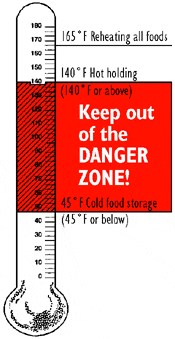Safe at home
by Marie Donadio, FoodWorks instructor
This article was originally published in July 2001
More than fifty percent of all food-borne illnesses are contracted in the home. According to the King County Department of Public Health, most of us have had foodborne illnesses. Symptoms are very much like those for stomach flu: diarrhea, cramps, and upset stomach. The most vulnerable to foodborne bacteria, contaminants, and toxins are infants and children, the elderly, and those with a weakened immune system. With warm weather, the risk increases. There are simple steps we can all take, however, to ensure that the food we prepare and serve is as safe and healthy as possible.
The most important safeguard against the cause and spread of disease is frequent handwashing. Always wash your hands thoroughly before beginning any sort of food preparation. Obvious as this may sound, it cannot be overemphasized: wash hands after using the restroom, sneezing, coughing, or handling trash or raw foods. Teach children good handwashing habits at an early age. Wash with warm water and plenty of soap; especially under fingernails. It’s a good practice to wash for 20 to 30 seconds. (This is a great time to practice counting in different languages!) Launder hand towels frequently to avoid spreading germs.
Moist, protein-containing foods are quicker and more likely to make us sick when mishandled. These foods include cooked beans, eggs and tofu as well as meat, fish, and poultry. Place raw meat, poultry or fish on the bottom shelf of the refrigerator so juices don’t drip onto foods that won’t be cooked before eating. Refrigerate all cooked foods, including potatoes and rice, after serving.
Sanitize
Wash, rinse, and sanitize cutting surfaces and utensils immediately after working with raw meat. One teaspoon of household bleach mixed with a gallon of cool water is a good sanitizing solution; a stronger solution will not be more effective. Bleach solution should be made fresh on the day it’s to be used and discarded in the drain at the end of the day.

Melon alert
Acidic fruits such as citrus, apples, and pineapple pose less risk than other summer fruit, especially melons. Melons are one of those fruits that are prone to picking up contamination from several sources, including human or animal waste. Wash the outside of the melon to remove dirt before cutting or serving. Refrigerate all cut fruits, particularly melons, to help prevent foodborne illness. Wash surfaces and utensils with hot soapy water and sanitize as you would for meat.
It’s vital to cool foods right away to prevent the growth of germs and toxins that cause illness. The range between 45° F and 165° F is known as the “Danger Zone.” Plan your shopping so groceries can go into the refrigerator as quickly as possible.
- Do not leave food sitting out for more than two hours without heating or refrigerating. Meat, dairy, and cut melons are particularly vulnerable. You may not get sick if you leave food out for more than two hours, but is it worth taking a chance? The best advice is “when in doubt, throw it out.”
- At home, cool foods quickly by freezing meat in batches no larger than four pounds. Cool soups, stews, beans, and large batches of rice in shallow pans. Cover foods only after the temperature has dropped below 45°F.
- Reheat foods to 165°F or above, moving through the danger zone as quickly as possible. It’s wise to invest in an instant read thermometer.
- Check refrigerator temperature at least seasonally. Be sure the setting is low enough to keep food safe, below 45°F. It’s still best to use foods quickly.
- Use raw meat, fish and poultry within two days of purchase, or freeze.
- Cooked meats such as deli slices are best eaten within three days.
- Always defrost food in the refri1gerator and use promptly.
Proper food handling can help us all enjoy a safe and healthy summer.
Marie Donadio is a Seattle-area writer and FoodWorks instructor. This fall at PCC, she’ll teach “Soup Simplifies Your Life” and “Eating Well with Food Allergies,” two of her most popular classes.
